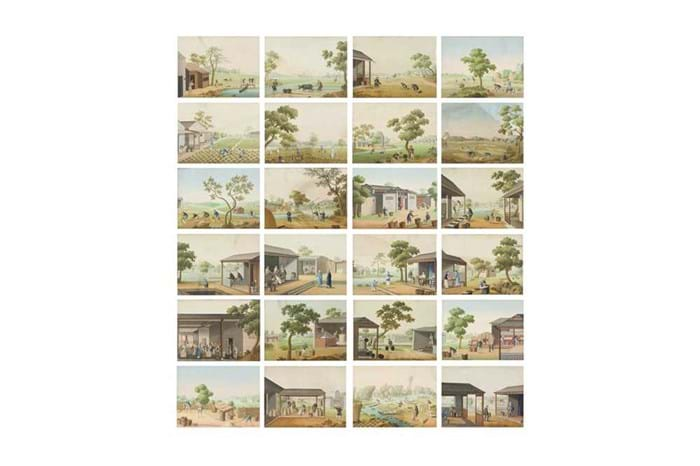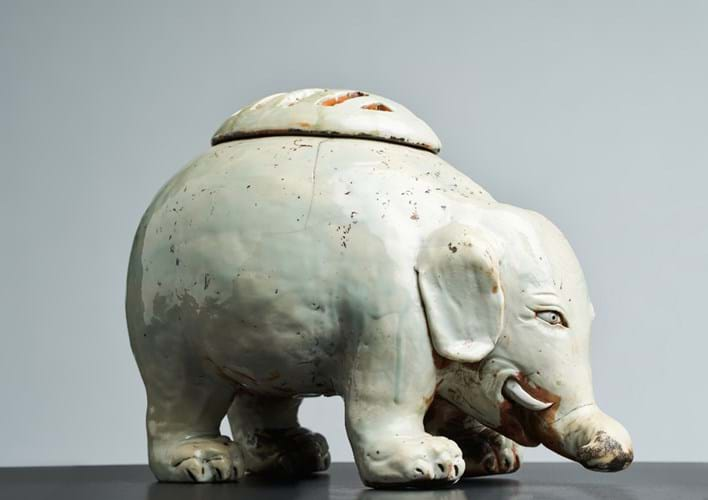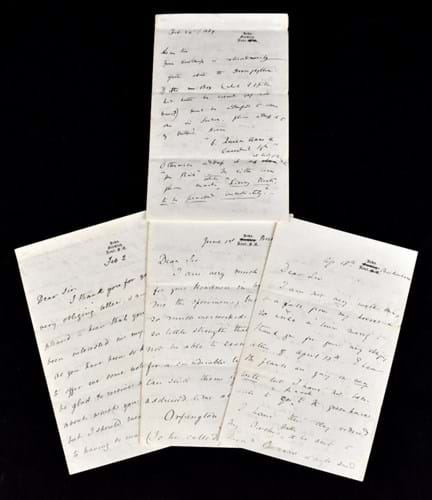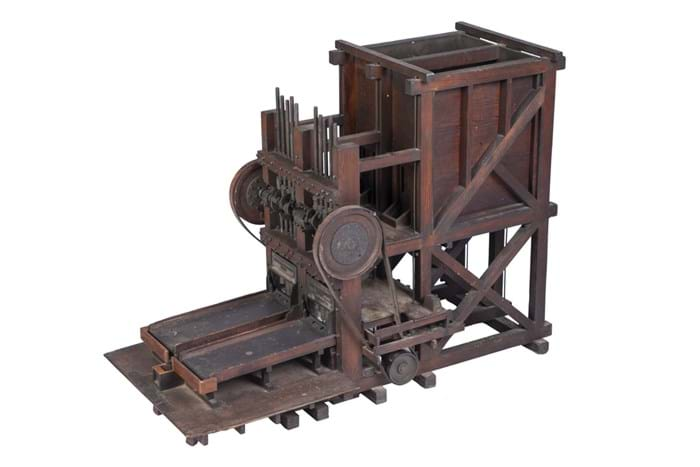1. Japanese porcelain elephant – £24,000
Early Japanese porcelain models of animals are very rare, and this elephant form koro c.1700, above, offered for sale as part of the Woolley & Wallis Japanese works of art sale on November 22, appears to be unrecorded.
Measuring a massive 15in (38cm) across, the large pachyderm is modelled standing four-square, its curled to the right and a gentle expression on its face. A cover with a double row of apertures for the smoke to escape allows it to function as a censer.
Once possibly covered in a cold-painted decoration, the base is inscribed with lines of calligraphy possibly the names of the worshippers at a temple who commissioned the piece for local community use. Similar inscriptions appear to the Kakiemon model of a lion dog offered to the Sonobe Shinto shrine in 1692.
This elephant, from a private collection in Suffolk, shares the same thick, bluish glaze and deep firing faults with a model of a seated deer sold by the auctioneers in June 2000 from the collection of Lord and Lady Broughton, 3rd Baron Fairhaven of Anglesey in Cambridge.
The elephant, with its obvious condition issues, was guided at £1000-2000 but did much better, selling at £24,000.
2. Channel Islands coffee pot – £4900
This late 18th century Channel Islands silver coffee pot has marks for the Jersey silversmith Jacques Quesnel I. An engraved inscription to the base suggests its first owner was Jeanne Le Couteur, the mother of General Helier Touzel (1779-1865), the only Jerseyman to have risen to the rank of full general in the British army.
It came for sale at Piers Motley in Exmouth on November 22-23, from a descendent of the original owner. Jersey silver carries a significant premium over London-made pieces of the same period. It was estimated to bring £3500-6000 and that guide proved spot on when it sold at £4900.
3. Charles Darwin letters – £25,200
A group of four Charles Darwin (1808-1882) letters sold for £25,200 at Adam Partridge in Macclesfield on November 17-19. The four letters, one written and autographed by Darwin and three written by his wife Emma and signed by Charles Darwin, were penned in 1869 to Charles Caster Tait, a British naturalist and author of The Birds of Portugal in 1924.
All four letters discuss Tait acquiring specimens of Drosophyllum Lusitanicum for Darwin in Portugal, a February 2 letter includes notes on tailless dogs while letters dated February 24 and April 18 reference the horns of Merinos sheep – thought to be a response to Darwin’s publication of The Variations of Animals and Plants Under Domestication in 1868. Darwin also adds that he is not very well following a fall from his horse.
The estimate for the quartet, offered as a single lot, had been £4000-6000.
4. Qianlong period paintings – £140,000

Series of 24 Qianlong period paintings depicting tea production in China – £140,000 at Chiswick Auctions.
A welcome late entry to the Asian Art sale at Chiswick Auctions on November 18 was a series of 24 paintings depicting tea production in China. While similar works were not uncommon in the 19th century, this set is exceptionally early, detailed and extensive.
They also have an exceptional provenance. They were acquired during Lord Macartney’s diplomatic trade mission to China in 1792-94 and have passed through four generations of the British nobility at Crewe Hall.
One of the paintings was lost in the 1980s (when exhibited in 1997 as part of the A Tale of Three Cities: Canton, Shanghai and Hong Kong show, only 23 were shown) but it has since been rediscovered and a legal agreement reached to reunite it with the others.
They were estimated to fetch £30,000-50,000 but bidding continued to £140,000.
5. Model of a Australian stamp mill – £17,500
This large scale model of a late 19th century Australian stamp mill is signed for the Ivanhoe Gold Corporation Foundry – a mining firm that operated in Western Australia between 1897 and 1948.
Measuring 1m (3ft 4in) across, the model, probably made as a salesman sample or as a boardroom novelty, features two mills fed by a single metal lined hopper with the ‘crushers’ driven by cams and leather belts.
Mills such as this (also called stamp batteries or stamping mills) were an important part of the Australian ‘gold rush’ and were used to break down metallic ores after extraction. ‘Salesman samples’ or ‘patent models’ were popular in the late 19th and early 20th centuries, as they were easily transportable and allowed dealers to display a variety of items in their showrooms that could then be ordered directly from a manufacturer.
Unlike toy versions aimed at children, they are typically made with working parts to demonstrate full functionality. They have a strong following in the collecting market and this one, offered with a modest guide of £1000-2000 at Flints in Thatcham, Berkshire on November 18, sold at £17,500.









